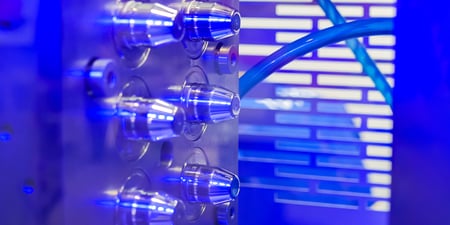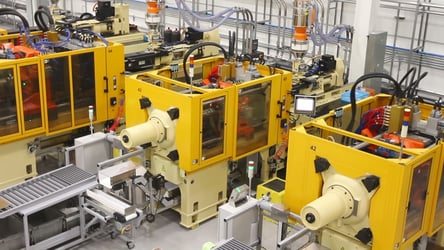Over the past several years, I’ve been dealing with the issue of tackling the hot runner manifold more and more frequently. I worked closely with a few customers who had issues with hot runner cleaning. Although each issue was different, most often the pain point was a hang up of color that can be extremely problematic to remove.
When it comes to purging, if the machine is not 100% clean in ALL parts it might as well not be cleaned at all. Time spent cleaning the screw and barrel equates to nothing if you still have contamination in other parts, i.e. the die or the gates. When it comes to manufacturing, keeping rejection rates low and production high is VITAL, and if there is a hang up in even the tiniest of areas, it can lead to very high rejection rates.
When using a mechanical purge, we offer several tips to ensure the machine is cleaned ALL THE WAY THROUGH, from start to end.
- Clean the screw and barrel by putting the screw in the most forward position and increasing screw speed to the maximum safe speed – this provides maximum turbulence and agitation inside the barrel, which in turn provides maximum cleaning power.
- Clean the check ring by carrying out 2-3 high velocity short shots – this allows the screw to push out any hang up at the nozzle.
- Clean the hot runners by carrying out some regular injection shots – this can be done via closed mold OR open mold cleaning.
Many tips can be used to improve your chances of completely cleaning manifolds. To increase flow, it is recommended to increase manifold temps by 55F, this will reduce the chance of clogging and will also help dislodge stubborn deposits. Increasing temperatures will allow the purge to flow easily through the manifold and into the mold, however the reduced viscosity can lead to reduced cleaning power in this area. In the case of multiple-gated hot runners, therefore, tackling one or two gates at a time can be a good way to increase the localized pressure going through each opening at a time – this allows more power and effective cleaning through each gate.
I was recently performing a trial at an automotive part manufacturer using our recommended purging instructions.
Results showed that the mechanical purge did an excellent job at cleaning the screw and barrel, but it was NOT as effective when it came to the hot runner.
A hang up of color, particularly coming from 2-3 drops, appeared as a fine blue streaking that was visible in the end product. This led to a high rejection rate before a completely clean part was made.
The manufacturer was able to identify that this streaking was only apparent when using a particular color resin. With further research into the resin, it appeared to be an organic pigment being used in the colorant that was problematic to remove.
As a mechanical purge was not providing sufficient cleaning in the manifold, we decided to try something stronger, and switched to a chemical purge.
A chemical purge works by heat and containment -- NOT abrasion, therefore cleaning is not inhibited in any area of the machine. For a chemical purge, the system was first flushed clean (using a resin as stiff as the production resin), and the purge was then allowed to enter the barrel at the regular processing temperature 420F (hopper to die), heats were increased at the manifold by 55F (475F) and the purge was left in the machine for a 20-minute soak time.
The chemical purge worked well and was able to remove contamination from the barrel completely in just one soak, the manifold however still showed some contamination. A second purge was carried out, this time increasing temperature in the manifold by a further 55F (530F) and leaving the purge in the system for another 15-minute soak, after the second purge results showed a much cleaner manifold.
Although a mechanical purge can be great for cleaning the screw and barrel, and is very easy to use (allowing you to go straight in and out from one production resin to the next), sometimes spending a little more time on your purge process and using a chemical purge can give you the edge needed to thoroughly clean those hard to reach areas. Most processors do not prefer to leave the machine idle for a 20-minute soak time, or repeat a purge process 2-3 times, however in many cases, investing the time in the purge process means that time taken to get to a good part can be significantly reduced.
It is worth keeping in mind that hard to reach areas like those in hot runner manifolds or sometimes sheet and film dies, are not always easily tackled by a mechanical purge (where pressure and abrasion are vital to achieving optimum cleaning power). In those instances, it is usually worth looking into the benefits of using a chemical purge and investing a little more time, to improve your chances of winning the battle.
Learn how the right purging compounds and procedures impact your process efficiency.

Kiran Raza is an Asaclean Purging Expert & Technical Sales Representative. She's worked in the plastics industry for nearly 20 years and has expertise In Bio-Medical Materials, Polymer Processing, and Materials Testing.









Comments